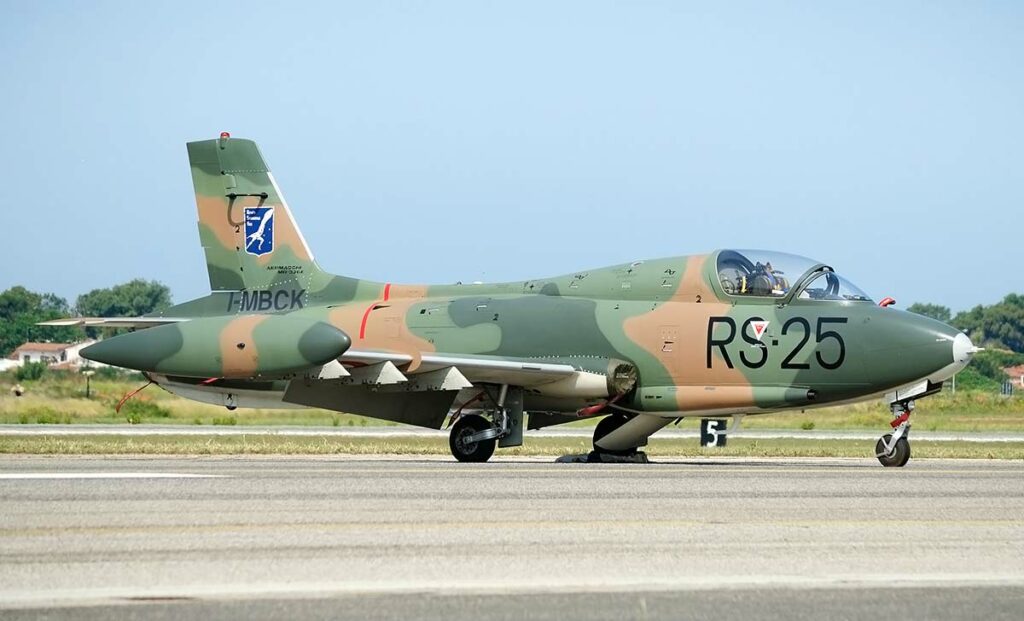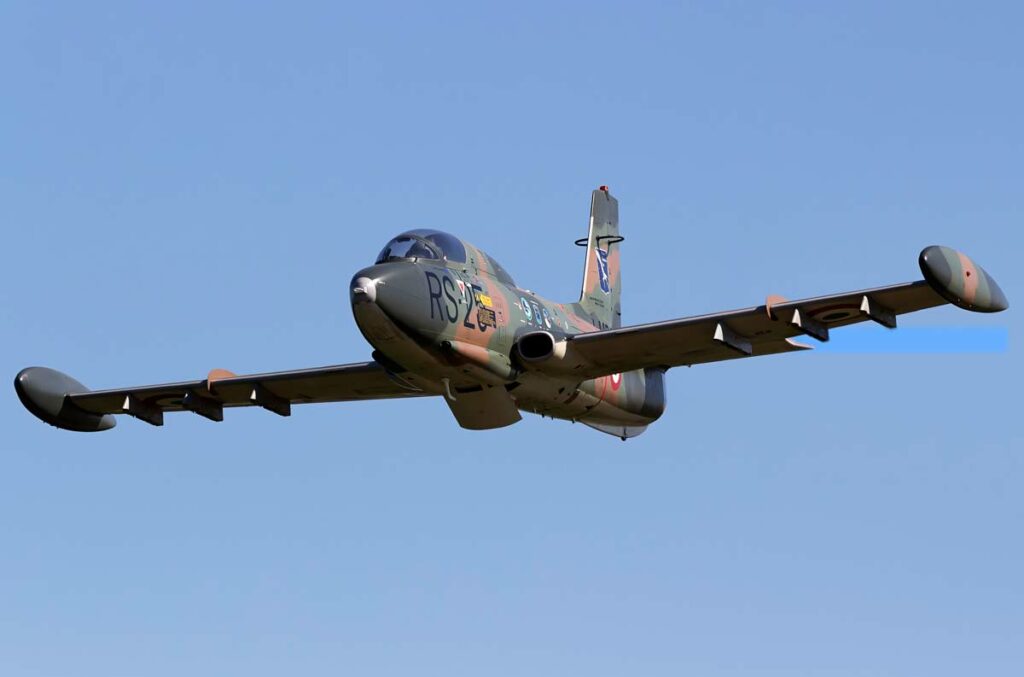Italian-built Aermacchi MB.326, a light military jet trainer and ground attack aircraft, first flew in 1957, showcasing versatility and reliability.
In Brief
The Aermacchi MB.326 is an iconic Italian jet trainer and ground attack aircraft designed in the mid-1950s. Developed by Aermacchi, it was intended to meet the training needs of military pilots transitioning to jet-powered aircraft. Powered by a Rolls-Royce Viper turbojet engine, it features a single-engine, straight-wing configuration, offering a balance between performance and ease of handling. The MB.326 was notable for its robust construction, reliability, and cost-effectiveness, making it a popular choice for air forces worldwide. Its versatility allowed for various configurations, including armed versions for light attack roles. The aircraft’s design emphasized simplicity, durability, and operational flexibility, contributing to its widespread adoption and long service life in numerous countries.

History of the Development of the Aermacchi MB.326
The Aermacchi MB.326 emerged during a pivotal era in aviation history, as air forces worldwide transitioned from propeller-driven to jet-powered aircraft. This shift necessitated a new generation of training aircraft capable of preparing pilots for the complexities of jet flight. Recognizing this need, Italian manufacturer Aermacchi initiated the development of the MB.326 in the early 1950s under the guidance of chief designer Ermanno Bazzocchi.
The objective was clear: create a versatile, efficient, and easy-to-maintain jet trainer that could also fulfill light attack roles. The program officially launched in 1954, with the Italian Air Force expressing keen interest in modernizing its training fleet.
The MB.326 first took to the skies on December 10, 1957, marking a significant milestone in Italian aviation. Its design was a response to both the technological advancements of the era and NATO’s growing demand for standardized training platforms. Although the MB.326 does not have a specific NATO nickname, its widespread service within various NATO countries underscored its international acceptance and versatility.
The aircraft’s development was a testament to Italy’s post-war industrial revival and its ambitions to play a crucial role in the global aerospace industry. By offering a blend of performance, affordability, and operational flexibility, the MB.326 positioned itself as an attractive option for air forces looking to modernize their training and light attack capabilities.
Design of the Aermacchi MB.326
The Aermacchi MB.326’s design was a product of meticulous engineering, aimed at achieving a balance between performance, reliability, and cost-effectiveness. It featured a straight-wing configuration, which provided stable and forgiving flight characteristics, essential for training purposes. The aircraft was powered by a Rolls-Royce Viper turbojet engine, delivering approximately 2,500 pounds of thrust (11 kN), which was later increased in subsequent models.
The MB.326 had a maximum speed of around 800 km/h (497 mph), with a service ceiling of 14,000 meters (45,932 feet) and a range of 1,800 kilometers (1,118 miles). Its dimensions included a wingspan of 10.85 meters (35.6 feet), a length of 10.65 meters (34.9 feet), and a height of 3.72 meters (12.2 feet). The aircraft’s design allowed for a gross weight of approximately 3,350 kilograms (7,385 pounds), showcasing its light yet robust structure.
One of the MB.326’s design advantages was its ease of maintenance and operation, attributable to the straightforward access to its engine and systems. However, its straight-wing design, while beneficial for training pilots, limited its speed and maneuverability compared to more advanced swept-wing jet trainers and combat aircraft. Nonetheless, its reliability, low operating costs, and flexible configuration options (including provisions for armaments and advanced avionics in later variants) made it a valuable asset for both training and light attack roles.
Performance of the Aermacchi MB.326
In terms of performance, the Aermacchi MB.326 set a high standard for jet trainers of its time. The Rolls-Royce Viper engine provided a solid foundation of power, enabling the aircraft to achieve a top speed of 800 km/h (497 mph) and a service ceiling of 14,000 meters (45,932 feet), with a climbing rate that could impress both trainee pilots and experienced aviators alike. Its range of 1,800 kilometers (1,118 miles) was sufficient for extensive training missions and light attack operations.
When compared to its contemporaries, the MB.326 stood out for its blend of performance, ease of handling, and operational versatility. For instance, while not as fast as some of the more advanced fighter jets of its era, its performance metrics were ideal for a training aircraft, providing a safe and controlled environment for pilots to learn the intricacies of jet flight.
The MB.326’s ability to operate from short runways, coupled with its robust construction, made it particularly suited for countries with varying operational environments and infrastructure. This versatility extended its service life and utility, allowing it to compete effectively with other jet trainers like the British BAC Jet Provost and the American T-37 Tweet, which shared similar roles but had distinct design philosophies and performance characteristics.
Variants of the Aermacchi MB.326
The MB.326’s adaptability led to the development of several variants, each tailored to meet specific operational requirements. The initial MB.326A was the basic trainer version, which set the standard for subsequent models. The MB.326G introduced an upgraded engine and improved avionics, enhancing its capability as a light attack aircraft. The MB.326K, known as the Impala in South African service, was a dedicated ground attack variant featuring hardpoints for weapons and external fuel tanks, demonstrating the aircraft’s dual-role capability.
Other notable variants include the MB.326M, a maritime patrol version equipped with specialized sensors and equipment for coastal surveillance missions, and the MB.326GC, a further improved ground attack version with advanced navigation and weapon aiming systems. Each variant maintained the core attributes of the original design while expanding the MB.326’s operational roles and capabilities.

Military Use and Combat of the Aermacchi MB.326
The Aermacchi MB.326’s military use spanned several decades, with numerous air forces adopting it for training, light attack, and reconnaissance roles. Its armament capabilities, including machine guns, rockets, and bombs, allowed it to perform a variety of combat missions effectively.
The aircraft saw combat in several conflicts, most notably with the South African Air Force during the Border War in Namibia and Angola, where it was used for ground attack missions against guerrilla forces. Its performance in these operations highlighted its reliability and effectiveness in combat conditions, often operating from forward airfields under challenging conditions.
Competing against aircraft such as the BAC Jet Provost and the T-37 Tweet, the MB.326 distinguished itself through its dual-role capability and operational versatility. Its export success to countries like Australia, Brazil, and South Africa, among others, underscored its international appeal and adaptability to different operational requirements.
Although eventually replaced by more modern trainers and light attack aircraft, the MB.326 left a lasting legacy. Its retirement from active service varied by country, with some air forces using it well into the 21st century before transitioning to newer platforms like the M-346 Master, which Aermacchi also developed, reflecting the enduring impact of the MB.326’s design philosophy.
The Aermacchi MB.326 represents a significant chapter in aviation history, embodying the transition to jet-powered flight in military training and light attack roles. Its design, performance, and operational versatility set benchmarks for future aircraft in its class. Despite its retirement, the MB.326’s legacy continues to influence modern aviation, marking it as a pivotal development in the evolution of jet training and ground attack aircraft.
Back to the Trainers section.